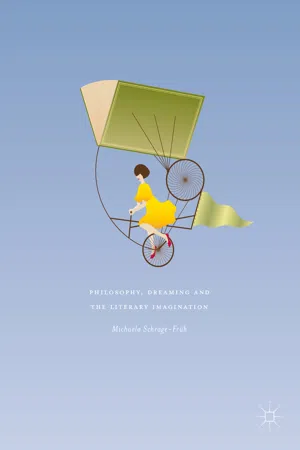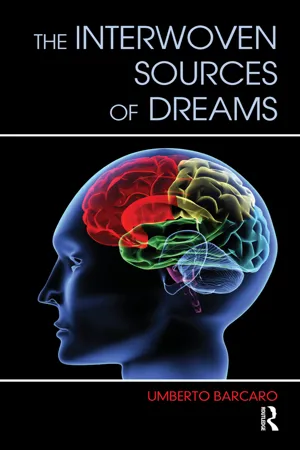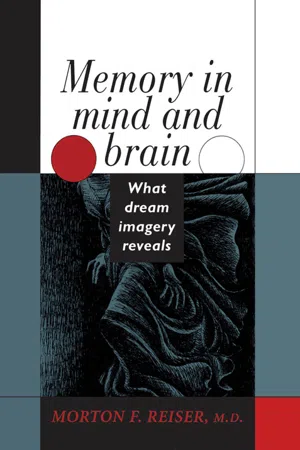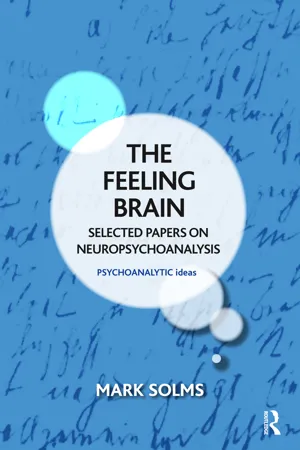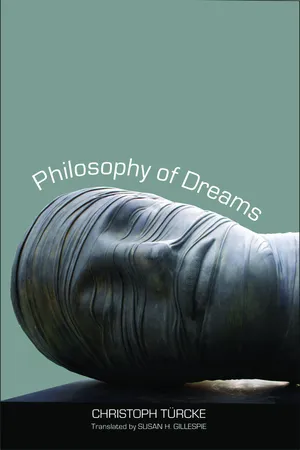Psychology
Activation Synthesis Theory
The Activation Synthesis Theory proposes that dreams are the result of random neural activity in the brain during REM sleep, which is then interpreted and synthesized by the brain into a narrative. According to this theory, dreams do not have inherent meaning or purpose, but are rather a byproduct of the brain's physiological processes during sleep.
Written by Perlego with AI-assistance
Related key terms
1 of 5
8 Key excerpts on "Activation Synthesis Theory"
- Michaela Schrage-Früh(Author)
- 2016(Publication Date)
- Palgrave Macmillan(Publisher)
[…] The forebrain also has the higher mental function of synthesizing or integrating different experiences into a coherent whole. […] Thus, […] the dream narrative is a forebrain synthesis of a hindbrain activation pattern—hence the term activation - synthesis hypothesis. The narrative is determined by physiological events, not by meaningful psychological events such as the disguised fulfillment of unconscious wishes. 61 In Hobson and McCarley’s view, the electric signals produced by the pontine hindbrain are both random and psychologically unmotivated, which accounts for what they consider the bizarreness of dreams or distortion of dream images. Thus, although the forebrain tries to ‘synthesize its random patterns into a meaningful whole’ by drawing on ‘ordered activation patterns of stored memories’, 62 these attempts are not always successful. With this explanation, Hobson and McCarley account for dream bizarreness and occasional dream coherence at one go. At the same time, ‘they were able to claim that since the generation of REM is an automatic, preprogrammed process, its unconscious mental correlate [dreaming] is as “motivationally neutral” (Hobson and McCarley, 1977, 1338) as the brainstem mechanism that generates your heartbeat’. 63 Dreaming, according to this view, is the result of the forebrain’s more or less successful attempts at coming up with ‘the best possible fit of intrinsically inchoate data produced by the auto-activated brain-mind’. 64 Nevertheless, Hobson, perhaps in a reconciliatory gesture towards those colleagues criticizing his earlier writings for ‘biological reductionism’, 65 clearly concedes that dreams are far from psychologically meaningless: The activation-synthesis hypothesis assumes that dreams are as meaningful as they can be under the adverse working conditions of the brain in REM sleep. The activated brain-mind does its best to attribute meaning to the internally generated signals- eBook - ePub
- Umberto Barcaro(Author)
- 2018(Publication Date)
- Routledge(Publisher)
The discovery of a relationship between REM sleep and dreaming favoured a “reductionist” approach: this term, proper of epistemology, indicates the idea that the phenomenon of sleep could (and should) be explained on purely neurobiological means. This approach has been severely criticized from the methodological point of view.The most remarkable product of the reductionist approach has been the model advanced by Hobson and McCarley (1977). Their theory, called “Activation-Synthesis Hypothesis of the Dream Process”, starts with an identification between REM sleep and dreaming that, despite some caution, appears as substantial: they distinguish three “principal operating states” in the Central Nervous System: Waking, Synchronized Sleep (that is, sleep in stages different from REM), and Desynchronized Sleep. They underline that this distinction derives from polygraphic recording including Electroencephalogram, Electromyogram and Electrooculogram. The Synchronized Sleep stage is called by the authors “D” state, in order to indicate not only Desynchronization, but also Dreaming; in fact, “hallucinoid dream” in man occurs predominantly, according to the authors, in this state.Let us now summarize the hypothesis by Hobson and McCarley in an extremely simplified way, only referring to two anatomical structures, the “pontine brain stem” and the “forebrain”. According to this model, during REM sleep the forebrain is activated by pontine cells and this activation pattern is then elaborated and integrated with previous experience in the forebrain: this synthesis produces the dream. The model consists of three steps: a) the generation of the D state; b) the activation of sensory neurons, motor neurons, and “visceral” neurons via disinhibition in D state; and c) the final step of Synthesis. According to the authors:“Synthesis integrates disparate sensory, motor, and emotional elements via condensation, displacement, and symbol formation. Increase in intensity gives vividness. Change in pattern gives scene and plot shifts.” (p. 1346)The authors insist on the differences between their model and the Freudian model of dream generation. Substantially, they present their model as a confutation of the Freudian Theory of dreaming. They underline that specific stimuli for dream imagery depend upon a largely random or reflex process and that therefore the formal bizarreness of the dream experience should not be interpreted as a defencive mechanism as psychoanalysis interprets it. In their model, “little or no primary ideational, volitional, or emotional content” (p. 1347) is responsible for the dream process. According to Hobson and McCarley, the stimuli coming from the brain stem are certainly elaborated by the perceptual, conceptual, and emotional structures of the forebrain, but this elaboration is a “synthetic constructive process” (p. 1347) which has nothing to do with the Freudian dream-work. - eBook - PDF
- Oleg V. Khlevniuk, Vadim A. Staklo(Authors)
- 1983(Publication Date)
- Yale University Press(Publisher)
REVISING DREAM THEORY events produces answers that reveal the person's cognitive style, and these afterthoughts may point to issues of current concern. Therefore, according to this view, inquiry and discussion are clini-cally useful in much the same way as inquiry into responses to projective psychological test stimuli such as the Rorschach or The-matic Apperception Test would be. This model, which Hobson and McCarley call the activation-synthesis hypothesus, has several immediately apparent shortcom-ings, in my view. First, if the imagery were indeed generated in such a random fashion, how would repetitive dreams be explained? The revised model proposed in this book is strongly supported by the phenomenon of repetitive dreams, especially those occurring in individuals suffering from severe emotional trauma, as in war ex-periences (Post-Traumatic Stress Syndrome), natural disasters, and other catastrophic experiences. In those instances the identical scenes, action, and overwhelming feelings of horror and terror occur over and over again in repetitive nightmares. Surely these repeated dreams are rigidly preprogrammed and could hardly be explained by random stimulation of the frontal cortex. Second, the model would not very well explain the clear and obvious relation of dream themes to current life problems. This close relationship is more frequently and regularly observed than would be expected if the dream were as randomly generated as the activation-synthesis model suggests. Moreover, studies of deep medial temporal lobe structures re-veal that electrical stimulation in the region of these structures may induce vivid dreamlike recall of earlier complex life experiences, including imagery that is sometimes intense enough to be hal-lucinatory (Ferguson et al. 1969; Mahl et al. 1964; Penfield and Jasper 1954; Penfield and Perot 1963). - eBook - ePub
The Feeling Brain
Selected Papers on Neuropsychoanalysis
- Mark Solms(Author)
- 2018(Publication Date)
- Routledge(Publisher)
The theoretical emphasis in the formula “brain activation during sleep triggers dreaming” falls on the word triggers. The mechanism of dreaming cannot be reduced to simple brain activation. The activation merely triggers a process that has a complex internal organization of its own. Recent research (Braun et al, 1997; Maquet et al., 1996; Nofzinger, Mintun, Wiseman, Kupfer, & Moore, 1997; Solms, 1997b) has revealed that dreams require the concerted activation of a tight network of brain mechanisms responsible for instinctual behaviours, emotion, long-term memory, and visual perception, with simultaneous deactivation of mechanisms responsible for reality monitoring and goal-directed motor activity. It appears that the instinctual and emotional mechanisms near the centre of the brain initiate the process, and that the “manifest” dream is the culmination of a process of backward projection (cf. Freud’s regression) onto the perceptual structures at the back of the brain (Solms, 1997b).These new findings are compatible with Freudian dream theory, in most respects. This is true even of Freud’s central claim that dreams give expression to peremptory wishes. Dreaming is obliterated completely by damage to only two brain structures. The first of these structures forms part of a network responsible for visuospatial perception and cognition. (These are the structures that the manifest dream is “projected” onto.) It is not surprising that they should be centrally involved in dreaming. The second structure is more interesting; this is the “SEEKING” system of Panksepp (1998a), which connects the midbrain to the limbic system and frontal lobes. No single brain system comes closer in its functional properties than this one to the “libido” of Freudian dream theory. It is therefore of no small interest that among the instinctual and emotional command systems implicated in dream generation, this one seems to be pivotal (Solms, 2000). Damage to this structure results in a total cessation of dreaming (together with sharply reduced motivation) and dreams can be artificially manipulated by stimulation and inhibition of this structure, without any concomitant effect on the REM state. - David Foulkes, David FOULKES(Authors)
- 2009(Publication Date)
- Harvard University Press(Publisher)
This sketch of dream phenomenology sounds nothing like my account of Dream A of adults and nothing like my data on the developing Dream A of children. It probably doesn’t even sound like most persons’ idea of their Dream B. But it does dramatize the idea of the randomness of an out-of-control dream process. Now the original idea of chaotic brainstem dream sources rests on the empirical observation that cortical and cognitive activation are initiated by the brainstem. But Hobson and McCarley ( 1977 ) further proposed that the informational sources of dreams come from that same level, and hence are both random and meaningless. But, modifying an analogy by an early critic of this theory, Gerald Vogel ( 1978 ), suppose that there’s a primitive mecha-nism in the cellar of a house that periodically turns on the lights and rouses the creatures living upstairs. What happens next depends entirely on the properties and traits of the crea-tures at the upper levels (it is to this point that Rittenhouse, Stickgold, and Hobson [ 1994 ] now make some small conces-Dreaming 130 sion). These creatures are not being guided at a distance from below, in the way that some psychotics believe their thoughts are under external control. In wakefulness, cortical arousal also is initiated by the brainstem, but no one, I suppose, imagines that the form or substance of waking conscious ideation is determined by the brainstem. Why, then, should we suppose this to be the case during sleep? There is no physiological evidence that REM and waking cortical arousal are in any important respect func-tionally different from one another (Steriade, 1996 ). There also is absolutely no independent evidence that subcortical neural arousal of the cortex is accompanied by a transfer of psycho-logical information capable of either influencing or reaching conscious representation.- eBook - PDF
Routledge Library Editions: Sleep and Dreams
9 Volume Set
- Various(Author)
- 2021(Publication Date)
- Routledge(Publisher)
Freud's method of interpretation assumes that dreaming is a specific kind of cognitive process. I would like to thank Kate Ruzycki for her careful and humorous editorial assistance. 251 252 Toward a Cognitive Psychology of Dreams On the other hand, for Jung (3), and more recently for James Hillman (4), dream interpretation is not seen as un- ravelling or reversing the pathways of dream formation, but instead aims to finish the dream through a set of techniques usually defined as "amplification." Thus the dream might be paraphrased to show its general metaphoric structure or con- nected to the cross-culturally common "archetypal" themes of mythology. For Jung and Hillman dream formation is a positive, abstract form of thought that conveys self-insight through a visual-imaginal or "presentational" cognitive mode. Here interpretation completes the dreaming process by rephrasing it in a verbal-representational mode, and so bringing home its potentially creative insights. No unravelling or reversing of an actual process of dream formation is involved. The key lies in a view of visual imagination and metaphor as an ab- stract cognitive faculty in its own right. More academic research-oriented approaches to dreaming have always been skeptical of attributing symbolic or meta- phoric meanings to dreams. Hobson and McCarley's (5) activa- tion-synthesis model of dream formation, for instance, points to the basis of the REM state in phasic discharge processes in the pontine formation of the brainstem--common to all mammals. They and other physiologists argue that what both Freud and Jung (for different reasons) took as symbolic features of dreaming--especially its bizarre, constantly shifting quali- ties--are the product of a non-psychological, more or less random discharge process in the brainstem. The presence of inhibited muscle movements in REMing animals (see below) would mean that dreaming is not a form of thinking at all. - eBook - PDF
- Christoph Türcke, Susan H. Gillespie(Authors)
- 2013(Publication Date)
- Yale University Press(Publisher)
But it has also been shown to activate certain higher regions of the brain. Evidently it excites them so they produce images. For when its effect has ended, after a few minutes, the dream also ends. The subject sleeps dreamlessly until the next REM phase is reached. This provided a simple physiological explanation for the entire activity of dreaming. Dreams are biorhythmically produced, the result of a kind of neural chance generator in the cerebellum that at regular intervals stimulates the cerebrum to produce more or less confused images. They make no sense. There is nothing about them either to understand or to interpret. Naturally, that was overly hasty. Not everyone who was awakened from REM sleep, as it turned out, was able to recount a dream. On the other hand, there were others who experienced dreams outside REM phases. People were even found who, due to damage to the pons, were incapable of REM sleep but still had dreams. Others had a completely intact pons area but dreamed nothing at all. In their cerebral cortex, above the eye sockets, a particular nerve bundle had been damaged that ordi-narily conducts impulses from the midbrain to the higher parts of the brain and that can always be seen to be particularly active when the organism is “appetitive,” that is, full of desire for external objects that are meant to relieve the inner tension of its needs. This pathway for wishes also proves to be constitutive of dreams. The same is no less true of the “occipital-temporal-parietal” transition region just behind the ears, in the cerebral cortex. It plays an essential role both in the conversion of concrete perception into abstract thought and in the retention of concrete percep-tion as abstract thought. If it is injured, human dreaming is also damaged beyond repair. Obviously, dreaming is a very complex process that is brought about not only by the cerebellum but to at least the same extent by the cere-brum. - eBook - PDF
Dreams and Visions
How Religious Ideas Emerge in Sleep and Dreams
- Patrick McNamara Ph.D.(Author)
- 2016(Publication Date)
- Praeger(Publisher)
Another route via which dream content might influence SA cognitions during waking life is via theory-of-mind attributions. THEORY-OF-MIND ATTRIBUTIONS We have seen how the cognitive processes associated with REM dream- ing are associated with emotional regulation and self-directedness. REM can produce conditions under which the mind would naturally construct SAs. The key process for the construction of SAs appears to be that dreams modulate the sense of agency or self-directedness in the dreamer such that they initially promote a reduction in agency in the dreamer along with a concomitant production of special abilities in another dream character. Those special abilities can easily extend into supernatural abilities where- upon we have the rudiments of an SA. Cognitions about SAs can occur during waking life because their constituent parts are produced in dreams and then held in working memory after awakening. In addition, there are reliable data (see Kleitman, 1982) that suggest that the REM cycle is tied to a similar daytime cycle wherein some aspects of REM intrude into wak- ing consciousness, and the individual drifts for a few minutes into day- dreams. These daytime micro-events of REM intrusions provide another platform for the production of basic cognitive elements of SAs and their irruption into consciousness. REM sleep neurophysiology is optimal for the production of the cogni- tive processes that give rise to SAs. During REM, the gamma rhythm cen- tered around 40 Hz becomes uncoupled in the cortical areas, between the Cognitive Processes in Dreams That Produce Religious Ideas 115 hippocampus and the cortex, and the intra-hippocampal gamma coher- ence is decreased. There is no resetting of the gamma rhythm by sensory stimulation during REM sleep. In every REM episode, there is an eleva- tion in dopamine and acetylcholine activity and a reduction in serotonin and norepinephrine activity.
Index pages curate the most relevant extracts from our library of academic textbooks. They’ve been created using an in-house natural language model (NLM), each adding context and meaning to key research topics.
